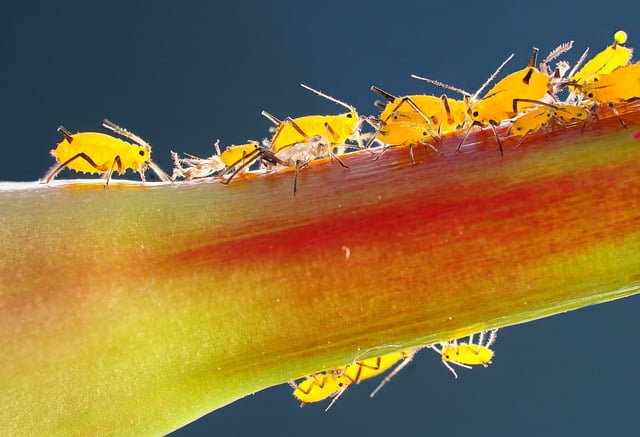Bed bugs pose a significant challenge due to their elusive nature, complex life cycle, and ability to reproduce rapidly. Effective bed bug treatment requires understanding their behavior, such as hiding in cracks, being attracted to carbon dioxide and heat, and laying hundreds of eggs. Early detection through regular inspections for bites, dark spots, and physical signs is crucial. Preventative measures like maintaining a clean environment, HEPA vacuuming, using bed bug-resistant covers, and professional treatments offer a multi-faceted approach. Combining traditional methods like heat treatments with modern tactics like protective covers and targeted insecticides ensures long-lasting protection against these persistent pests in both residential and commercial settings.
Long-term pest prevention requires a strategic approach, especially when dealing with resilient bed bugs. This comprehensive guide offers expert strategies to keep your space bed bug-free. We’ll first unravel their behavior and life cycle, helping you identify signs of an early infestation. Then, we provide a detailed prevention checklist for every corner of your home or business. Lastly, we explore effective treatment options, ensuring you’re armed with the right knowledge for swift and successful bed bug treatment.
Understanding Bed Bug Behavior and Their Life Cycle
Bed bugs are elusive pests, making their elimination a challenging task. Understanding their behavior and life cycle is a crucial step in successful long-term pest prevention. These insects thrive in hidden spaces, often infesting cracks and crevices in furniture, walls, and floors. They are attracted to carbon dioxide, heat, and moisture, making human habitats an ideal breeding ground. A female bed bug can lay hundreds of eggs during her lifetime, and the nymphs that hatch from these eggs undergo several molts before reaching maturity. This complex life cycle requires consistent and targeted bed bug treatment strategies to disrupt their reproduction and movement patterns.
By recognizing their behavioral patterns, you can implement effective prevention measures. Regularly inspect your surroundings for signs of bed bugs, such as small red bites on the skin or tiny dark spots left by their exoskeletons. Maintaining a clean environment is key; vacuuming regularly with a high-efficiency particulate air (HEPA) filter and sealing cracks and gaps in furniture can help deter these pests. Moreover, using bed bug-resistant covers for mattresses and pillows creates a physical barrier against infestation, making them an essential part of any long-term bed bug treatment strategy.
Identifying Signs of Infestation Early On
Early detection is key when it comes to long-term pest prevention, especially for stubborn intruders like bed bugs. By being vigilant and recognizing the subtle signs of an infestation, homeowners can take prompt action to eradicate them before they establish a strong presence. Regularly inspect your bedding, mattresses, and furniture for any visible signs such as tiny dots or stains caused by bed bug excrements, or small crusty areas where these pests have been feeding.
Pay close attention to areas where bugs thrive—cracks in walls, seams of upholstery, and dark corners. If you notice any unexplained itches or rashes on your skin, especially after sleeping, this could be an early indication of bed bugs. Promptly addressing these signs through professional bed bug treatment can prevent a minor issue from escalating into a full-blown infestation.
Implementing Prevention Measures: A Comprehensive Guide
Implementing prevention measures is a key strategy in long-term pest control, particularly for persistent issues like bed bugs. A comprehensive guide should start with understanding the habits and behaviors of the target pests. For instance, bed bugs thrive in dark, secluded areas and are often introduced through second-hand furniture or baggage. Therefore, regular inspections and meticulous cleaning routines are essential. Vacuuming regularly and sealing cracks and crevices can significantly reduce their hiding spots.
Additionally, maintaining a clean living environment is crucial. This involves washing bedding and clothing at high temperatures to kill any present bed bugs or eggs. Using bed bug-proof covers for mattresses and box springs creates a physical barrier, making it harder for these pests to establish a colony. Combining these measures with professional bed bug treatments, like heat or chemical applications, can provide a multi-faceted approach to long-term prevention and control.
Effective Treatment Options for Bed Bug Eradication
When it comes to bed bug treatment, a comprehensive approach is key to effective eradication. Beyond traditional pest control methods, professionals now employ a range of advanced techniques to ensure success. Heat treatments, for instance, use extreme temperatures to kill bugs and their eggs, making them particularly useful for hard-to-reach areas. Encasing mattresses and furniture in protective covers is another strategic move, creating a physical barrier against bed bug reinfestation.
Chemical interventions have also evolved, with modern insecticides designed to target bed bugs specifically. These treatments require careful application to minimize health risks and environmental impact. Combining these methods can lead to significant success in bed bug treatment, offering long-lasting protection for homes and businesses alike.
By understanding bed bug behavior, identifying early signs of infestation, and implementing robust prevention measures, you can significantly reduce the risk of these persistent pests taking over your space. Remember, proactive steps in pest control are key to maintaining a comfortable and hygienic living environment. For severe cases, seeking professional bed bug treatment is essential for complete eradication. With the right approach, you can reclaim your space from these unwelcome visitors.
